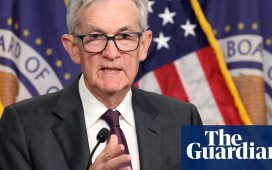This article is an on-site version of our Energy Source newsletter. Sign up here to get the newsletter sent straight to your inbox every Tuesday and Thursday
Hello and welcome back to Energy Source. We’re live from CERAWeek in Houston, arguably the most important annual event on the energy industry’s calendar.
Last year’s conference took place in the days after Moscow launched its full-scale invasion of Ukraine, plunging energy markets into chaos. Conversations around the Hilton Americas this year are all about the fallout from the war.
Energy security — and the record profits raked in by global energy companies — has been in the spotlight. America’s growing influence over global energy markets, a welcome development here in Houston, is also a hot topic. The reshaping of the global supply picture — and America’s pivotal role in it — is the subject of our first note.
But the even bigger matter is about how energy security can be achieved while the world also tries urgently to decarbonise. That’s the topic of note two.
In Data Drill, Amanda looks at a sharp drop in global electric vehicle sales recently, and what it tells us about China’s central role in propelling the EV market.
Thanks for reading and if you’re stomping the halls of the Hilton this week please get in touch! — Justin
Join us on March 15-16 at the FT’s Climate Capital Live, where politicians, business leaders and financiers will discuss how to move from climate commitments to real action. Register today and claim 10 per cent off your pass using promo code NEWS10.
Exit Russian gas stage left; enter US LNG
If last year’s CERAWeek conference was all about the scramble to cope with the chaos in global energy markets triggered by Russia’s invasion of Ukraine, this year’s one looks set to be about the long haul.
The knock-on effects from the war were centre stage yesterday, with the focus on how the world deals with the long-term impact — and how US companies might take advantage of the new status quo. Energy security, rather than energy crisis, is the phrase of choice.
In grand pronouncements from the stage and more candid conversations on the sidelines, the message was consistent: Russian gas is not coming back and there is an opening for someone else to fill the void.
As far as the executives gathered in downtown Houston were concerned, there is only one contender.
“The US is a big exporter and that will grow,” Chevron boss Mike Wirth told delegates at the outset of the conference. “That changes trade flows and it changes pricing mechanisms.”

The ‘balancing factor’
With the war rumbling on more than a year later, any hopes of a short-term disruption to energy markets have been buried. The energy order of recent decades has been altered irrevocably.
Torbjörn Törnqvist, chief executive of Gunvor, one of the world’s biggest commodity traders, said the loss of European markets was forcing Russia to shut in gasfields, as there was no easy way to redirect supplies to Asia.
As a result, shipments from America would become the “balancing factor”. “The world will not be able to live without US LNG,” he told delegates.
As more liquefaction capacity comes online, the US is set to become the world’s biggest exporter this year. And volumes are set to soar — dwarfing other players by the time the decade is out.
US gas producers are jostling to take advantage. Chesapeake Energy yesterday announced a preliminary agreement with Gunvor to supply it with 2mn tonnes of LNG annually for 15 years, beginning in 2027.
It is an early-days agreement — and it’s unclear at this point where Chesapeake will be doing its liquefying — but it underlines the rush to fill the gap Russia has left in global markets.
And drillers want to make money out of it — being paid international prices. Rather than selling at basement-level domestic Henry Hub prices, Chesapeake’s deal will be linked to the Asian JKM benchmark, currently more than four times higher.
Chesapeake boss Nick Dell’Osso told ES that upstream players wanted to gain exposure to global pricing.
“As LNG grows in the second half of this decade to something that represents greater than 20 per cent of the US market — probably closer to 25 per cent — we believe we should have exposure to the end markets that are going to ultimately drive the economics in the US business.”
Other upstream players have penned similar deals. EOG and Apache have agreements with Cheniere that give them exposure to international prices. Devon Energy struck a deal in September to give it access to liquefaction capacity.
“I think it is a direction that the industry will probably continue to head,” Dell’Osso said.
“At the end of the day the world is massively short energy. And the most effective form of energy to solve that problem is US natural gas.”
The FT also had the scoop last night on how the investment talks between Gunvor and the Abu Dhabi National Oil Company have reached an impasse.
(Myles McCormick, Justin Jacobs and Derek Brower)
Decarbonisation vs security
While energy security may have been the dominant theme, climate was never far from the agenda.
A panel featuring government officials from Europe and the US sparked some debate as to whether the energy crisis has derailed the transition.
Here are some of the punchier quotes:
Fred Krupp, president of the Environmental Defense Fund, said it plainly: the world can’t keep burning fossil fuels at the same rate it is now.
“It may not make me the most popular person here to say that whether you look at the analysis done by the [Intergovernmental Panel on Climate Change], or the analysis done by the International Energy Agency, it’s very clear we cannot meet our Paris goals if we continue to burn as much coal, oil and gas.”
Krupp added: “And when we see the latest energy crisis, it brings to mind how many different disruptions do we have to go through before we get serious that we need to move away from fossil fuels in a fundamentally different direction?”
Amos Hochstein, US special presidential co-ordinator for international energy security, said that the energy crisis accelerated the transition — but the world still needed fossil fuels, for now.
“I actually think that this crisis that we’re facing now because of the war in Ukraine — it’s not that it took us backwards, [making us] choose between the energy transition and the security crisis. The way I see it, [it has] accelerated many of the investments into the energy transition.”
“We do want eventually to see a reduction in demand for oil, but we can’t afford that right now. So we want to have the supply today, as we accelerate electrification, as we have electric vehicles taking up greater market share.”
Hochstein added: “I think if you’re going to be going through the greatest transformation the world has seen in over 100 years, unplugging from one energy system and creating a whole other one . . . you have to make sure that you don’t take off the supply before you have that ability to supply the alternative, because that friction is what creates energy shocks, which leads to political instability and ultimately leads to a lack of support or confidence in the energy transition itself.”
Ditte Juul Jørgensen, European Commission director-general of energy, said Europe would continue to put climate at the heart of energy security policy.
“All of these things we have to do to essentially stay energy-secure through this crisis were also aligned with the green transition. It was an acceleration of renewables . . . making sure that the diversification was to cleaner sources, but also making sure that the investments we make do not tie us into the past, but rather tie us into that energy transition that we’re going through.” (Myles McCormick)
Data Drill
Global electric vehicle sales slumped in January, falling nearly 50 per cent month-to-month, as crucial markets phased down subsidies, according to Rystad Energy.
China, the largest market for EVs, helped drive the decline, with 363,000 fewer vehicles being sold in January than the previous month, according to Rystad. Beijing ended its EV subsidies, which have been around since 2009, at the end of last year, prompting carmakers like Tesla to enforce price cuts.
Germany also saw a dramatic collapse in EV sales, with demand falling about a third month-to month after the country cut subsidies by €1,500 for vehicles up to €45,000 and excluded plug-in hybrids from subsidies.
The US is among the few countries to introduce new incentives in its landmark Inflation Reduction Act climate legislation, including a $7,500 consumer tax credit for models assembled in North America. Rystad predicts EV adoption will reach 10 per cent in the US for the first time this year.
The US subsidies have soured trade relations with Europe, which worries they will disincentivise manufacturing on the continent. On Friday, Volkswagen announced plans to build a $2bn EV plant in South Carolina, the latest European company to launch new production facilities in the US since the passage of the IRA.
“Right now, the EU is rapidly losing ground to both China and the US,” said Abhishek Murali, a clean tech analyst at Rystad. While China has seen weakening demand for EVs, its years-long technological advantage in the sector has made it a crucial player in spurring EV adoption in other countries, says Murali. (Amanda Chu)

Power Points
Energy Source is a twice-weekly energy newsletter from the Financial Times. It is written and edited by Derek Brower, Myles McCormick, Justin Jacobs, Amanda Chu and Emily Goldberg.
Recommended newsletters for you
Moral Money — Our unmissable newsletter on socially responsible business, sustainable finance and more. Sign up here
The Climate Graphic: Explained — Understanding the most important climate data of the week. Sign up here







